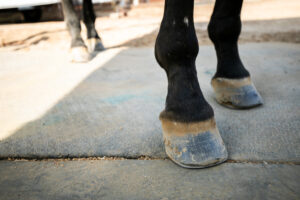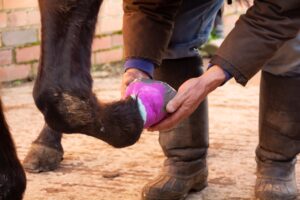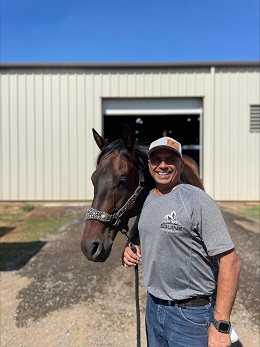Yesterday, your horse was better than ever. Today, they appear to be crippled, as if they have a lame foot. What could this mean?
While alarming, this situation is actually quite common. When you see your noble steed in this state, your first thought may be that they have a broken leg. However, it’s much more likely that they’re suffering from a hoof abscess.
Fortunately, this problem can be treated and will heal like a charm with the right care. Below, we’ll break down the steps that can get your horse back on their feet.
What is a Horse Hoof Abscess?

A horse hoof abscess occurs when bacteria get trapped inside your horse’s hoof. These bacteria cause a bubble of pus to develop behind the hoof wall. As it festers, the abscess causes painful pressure to build up inside your horse’s foot.1
Horses can develop hoof abscesses any time of the year, but certain weather conditions make them more likely:
- Wet weather – During rainy seasons, the wet weather is a breeding ground for bacterial infection. Rain can also wash away dirt from the ground, allowing pointy rocks and pebbles to stick out more notably. If your horse steps on one of these sharp objects, it could get lodged in their hoof and bring the bacteria with it.
- Dry weather – On the opposite end of the spectrum, dry environmental conditions can also lead to hoof abscesses, especially if your horse’s feet become brittle and cracked. As their hooves dry out, they can develop tiny cracks. This type of hoof crack leaves the perfect opening for bacteria to fester.
How to Identify a Hoof Abscess
The tell-tale sign of a hoof abscess is overnight severe lameness. Some additional signs include:
- One injured foot – Abscesses generally only impact one hoof. If multiple hooves are crippled at the same time, your horse may be suffering from another condition, like laminitis.2
- A hot, throbbing pulse – Another indication of a hoof abscess is a hot, throbbing pulse surrounding the lame foot.
- Signs of a lodged object – Small lodged objects can cause hoof abscesses to develop. If you notice a lodged object in your horse’s affected hoof, like a nail, woodchip, rock, or piece of glass, it could offer more data for your diagnosis.
Note: If an object is lodged in your horse’s hoof, don’t remove it yourself—leave that to your vet or farrier. They will want to examine the size and depth of the horse cut before they treat it. Oftentimes the real damage comes from improper extraction rather than the puncture wound.
- Visible pus drainage – If the abscess has already ruptured, you may notice pus draining from the sole of the foot.
Checking for these signs can give you a better idea of whether your horse is dealing with a hoof abscess or something else. However, it’s always a good idea to have your vet and/or farrier
confirm the diagnosis and rule out other serious conditions.
Healing Abscesses in Horses

To heal an abscess in horses, it’s best for the farrier or vet to identify where the abscess is, open it up and allow the infection to drain. However, some abscesses rupture on their own during home treatment. Other more severe cases may need to be drained surgically with the help of your vet and/or farrier.
If you decide to treat the abscess at home, simply follow the hoof care steps below:
#1 Clean the Foot
First, you need to clean your horse’s foot. Start by picking out the loose debris and give the hoof a thorough picking, then remove any excess dirt and debris with a hoof brush.
#2 Create a Foot Pack
Once the foot is clean, you need to prepare a foot pack. This pack will help draw the abscess to the surface.
To create this pack, you will need:
- A poultice – A poultice is a soft, moist pad or clay pack that may contain an antiseptic, which will help draw the abscess out.
- A cloth bandage – Any cloth bandage that’s large enough to cover your horse’s hoof will do.
- Vet wrap – Vet wrap is a stretchy, self-adhering bandage. It should be a staple in your equine first aid kit.
- Duct tape – You can use any strong duct tape you have on hand.
#3 Apply the Foot Pack
Once you’ve gathered these materials, you can apply the foot pack by following these steps:
- Prepare the poultice pad – To start, soak the poultice in warm water. If you have any Epsom salt available, you can soak the affected hoof prior to applying a pack or poultice. After that, position the pad at the bottom of your horse’s foot. Once applied, the poultice will soften the sole of your horse’s foot and encourage the abscess to rupture.
- Secure the poultice pad with the bandage and vet wrap – As you hold the poultice in place, arrange a bandage over it and secure the bandage with vet wrap. While you want the vet wrap to stay secure, you don’t want it to be too tight either, as it could restrict your horse’s blood flow.
- Complete the pack with duct tape – To finish off the foot pack, wrap the bandage in a layer of duct tape. Make sure there aren’t any gaps between the pieces of tape. This tape will serve as a protective barrier between the ground and the foot pack, ensuring everything stays intact and clean throughout the day.
- Change the pack daily – To keep the poultice from drying out your horse’s foot, replace the pack every day. You can soak your horse’s foot in a bucket of water with Epsom salt for 20 minutes between foot pack replacements.
- Repeat this process daily until the abscess ruptures – Once the abscess ruptures, your vet will need to make sure that there’s been complete drainage before it heals. Otherwise, any remaining bacteria could potentially lead to recurrent hoof abscesses.
As you can see, creating a foot pack is a simple process. Better yet, it’s a safe and effective home treatment for hoof abscesses. It won’t hurt your horse—if anything, the pack will offer your horse’s affected leg some cushion and pain relief while also promoting hoof health and recovery.
#4 Administer an Anti-Inflammatory
If your poor pony is experiencing severe pain, your vet may recommend giving it an anti-inflammatory. However, this medication should only be used as a last resort.
You don’t want to give your horse too much anti-inflammatory medication, since it may prevent the abscess from festering enough to rupture, prolonging the healing process.
Hoof Healing Made Easy

When your horse has a hoof abscess, it needs your tender loving care. As a horse owner, you can give it the best care possible with the help of Vetericyn.
Our Hoof Soak can clean, flush, and moisturize your horse’s wounds, kickstarting the healing process towards complete hoof health. This non-toxic treatment is antibiotic-free, so you can safely use it as a part of your equine home first aid kit.
Whether you’re dealing with horse abscesses, horse rashes or looking for horsefly bite treatment, Vetericyn is here to help in providing the best products and resources for horse care. By choosing Vetericyn, you’ll be giving your favorite furry neigh -bor the very best.
 Reviewed by Solomon Benarroch, Veterinarian
Reviewed by Solomon Benarroch, Veterinarian
Solomon Benarroch DVM has been a practicing veterinarian for over 30 years. His primary focus has been in equine soundness and performance sports medicine. Originally from Winnipeg, Canada he attended college at the Western College of Veterinarian Medicine. And completed an internship at the University of Minnesota. He is the father of three kids and when he isn’t working (which is rare), he enjoys traveling, cooking, and spending time with friends and family.
Sources:
- American Association of Equine Practitioners. Hoof Abscesses. https://aaep.org/horsehealth/hoof-abscesses
- American Association of Equine Practitioners. Laminitis: Prevention & Treatment. https://aaep.org/horsehealth/laminitis-prevention-treatment